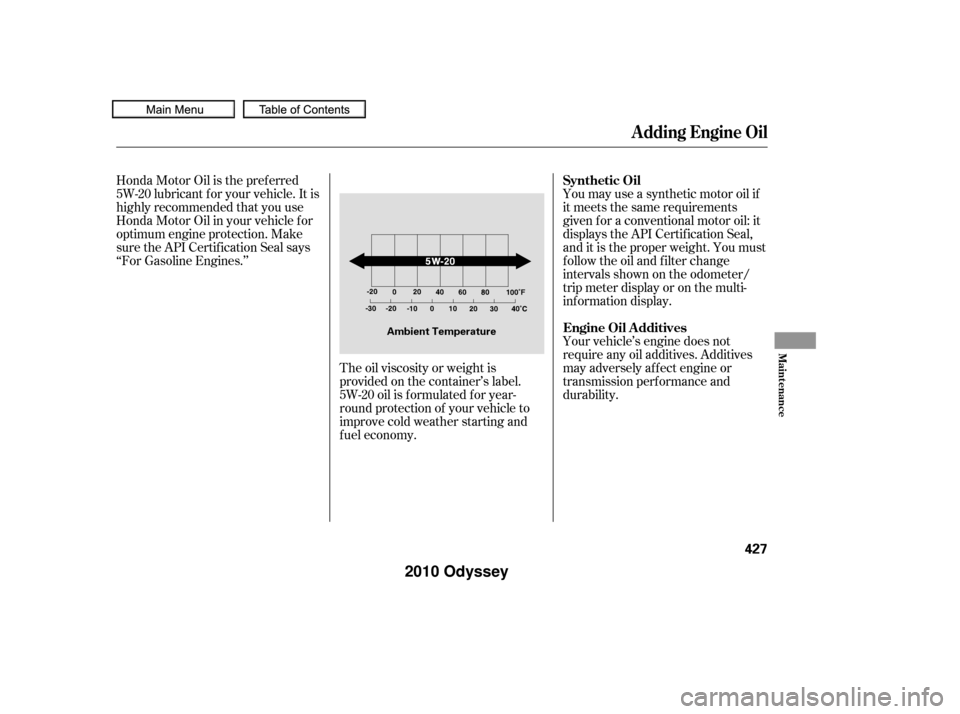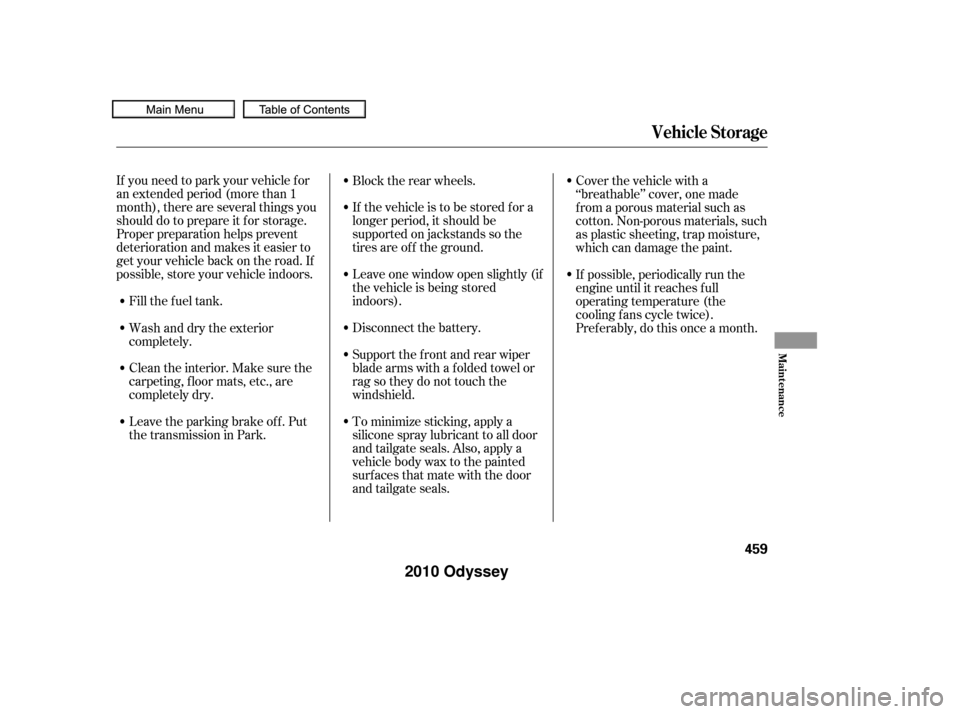Page 416 of 526

This section explains why it is
important to keep your vehicle well
maintained and how to f ollow basic
maintenance saf ety precautions.
This section also includes
instructions on how to read the
maintenance minder messages on
the inf ormation display or multi-
inf ormation display (depending on
models), and instructions f or simple
maintenance tasks you may want to
take care of yourself .
If you have the skills and tools to
perf orm more complex maintenance
tasks on your vehicle, you may want
to purchase the service manual. See
page f or inf ormation on how to
obtain a copy, or see your dealer.......................
Maintenance Saf ety .414
....................
Maintenance Minder . 415
..............................
Fluid Locations .425
........................
Adding Engine Oil .426
Changing the Engine Oil and ...........................................
Filter .428
..............................
Engine Coolant .430
....................
Windshield Washers .432
....
Automatic Transmission Fluid . 433
....................................
Brake Fluid .435
....................
Power Steering Fluid . 436
....................................
Timing Belt .436
.............................................
Lights .437
................
Cleaning the Seat Belts . 444
.....................................
Floor Mats .444
..................
Dust and Pollen Filter . 444
.................................
Wiper Blades .445
...........................................
Wheels .450
...............................................
Tires .450
...................
Checking the Battery . 458
.............................
Vehicle Storage .459
511
Maintenance
Maint enance
413
�����—�����—�
���y�
�������������y���
�(�����������y�����
���y
2010 Odyssey
Page 426 of 526

�µ
�µ
�µ
�µ
�µ
�µ
�Ì
U.S. Vehicles:
Youshouldcheckthefollowing
items at the specif ied intervals. If
you are unsure of how to perf orm
any check, turn to the appropriate
page listed. Lights Check the operation of
the headlights, parking lights,
taillights, high-mount brake light,
and license plate lights monthly.
See page .
Engine coolant level Check the
radiator reserve tank every time
you f ill the f uel tank. See page . Engine oil level Check every
time you fill the fuel tank. See
page .
Automatic transmission Check
the f luid level monthly. See page .
Brakes Check the f luid level
monthly. See page .
Tires Check the tire pressure
monthly. Examine the tread f or
wear and foreign objects. See page .
According to state and federal
regulations, f ailure to perf orm
maintenance on the items marked
with will not void your emissions
warranties. However, all
maintenance services should be
perf ormed in accordance with the
intervals indicated by the odometer/
trip meter display or the multi-
inf ormation display.
371
372
433 435 437
451
CONT INUED
Maintenance, replacement, or
repair of emissions control
devices and systems may be done
by any automotive repair
establishment or individual using
parts that are ‘‘certif ied’’ to EPA
standards. Owner’s Maintenance Checks
Maintenance Minder
Maint enance
423
�����—�����—�
���y�
�������������y���
�(�����������y���������y
2010 Odyssey
Page 427 of 526

�µ
�µ
�Ì
�Î
�Î
�Ì �Ì
�Î
Maintenance Minder
424
:
If the message ‘‘SERVICE DUE NOW’’ does not appear more than 12 months
after the display is reset, change the engine oil every year.
See information on maintenance and emissions warranty on page .
Inspect idle speed every 160,000 miles (256,000 km).
Adjust the valves during services A, B, 1, 2, or 3 only if they are noisy. Independent of the maintenance messages in the information display,
replace the brake fluid every 3 years.
NOTE: 1:
423
Maintenance Sub Items
Rotate tires
Replace air cleaner element If you drive in dusty conditions, replace
every 15,000 miles (24,000 km).
Replace dust and pollen filter If you drive primarily in urban areas that have high
concentrations of soot in the air from industry and
from diesel-powered vehicles, replace every 15,000
miles (24,000 km).
Inspect drive belt
Replace transmission fluid
Replace spark plugs
Replace timing belt and inspect water pump If you drive regularly in very high temperatures (over
110°F, 43°C), in very low temperatures (under 20°F,29°C), replace every 60,000 miles (U.S.)/100,000 km
(Canada).
Inspect valve clearance
Replace engine coolant
Maintenance Main Items
Replace engine oil
Replace engine oil and oil filter
Inspect front and rear brakes
Check parking brake adjustment
Inspect these items: Tie rod ends, steering gear box, and boots
Suspension components
Driveshaft boots
Brake hoses and lines (including ABS/VSA)
All fluid levels and condition of fluids
Exhaust system
Fuel lines and connections
A
B
Symbol
Symbol
1
2
3
4
51
1
Maintenance Minder
�����—�����—�
���y�
�������������y���
�(�����������y���������y
2010 Odyssey
Page 428 of 526
Fluid Locations
Maint enance
425
ENGINE OIL DIPSTICK
(Orange loop)WASHER FLUID
(Blue cap) BRAKE FLUID
(Black cap)
ENGINE COOLANT RESERVOIR AUTOMATIC
TRANSMISSION
FLUID DIPSTICK
(Yellow loop)
POWER STEERING FLUID
(Red cap)
ENGINE OIL FILL CAP
RADIATOR CAP
�����—�����—�
���y�
�������������y���
�(�����������y���������y
2010 Odyssey
Page 430 of 526

Honda Motor Oil is the pref erred
5W-20 lubricant f or your vehicle. It is
highly recommended that you use
Honda Motor Oil in your vehicle f or
optimum engine protection. Make
sure the API Certif ication Seal says
‘‘For Gasoline Engines.’’You may use a synthetic motor oil if
it meets the same requirements
given f or a conventional motor oil: it
displays the API Certif ication Seal,
and it is the proper weight. You must
f ollow the oil and f ilter change
intervals shown on the odometer/
trip meter display or on the multi-
inf ormation display.
Your vehicle’s engine does not
require any oil additives. Additives
may adversely af f ect engine or
transmission perf ormance and
durability.
The oil viscosity or weight is
provided on the container’s label.
5W-20 oil is f ormulated f or year-
round protection of your vehicle to
improve cold weather starting and
f uel economy.
A dding Engine Oil
Synthetic Oil
Engine Oil A dditives
Maint enance
427
Ambient Temperature
�����—�����—�
���y�
�����������
�y���
�(�����������y���������y
2010 Odyssey
Page 436 of 526
CONT INUED
Insert the dipstick all the way into
the transmission securely as
shown in the illustration.
Remove the dipstick, and check
the f luid level. It should be
between the upper and lower
marks.
Remove the dipstick (yellow loop)
f rom the transmission, and wipe it
with a clean cloth.
Check the f luid level with the engine
at normal operating temperature.
Park the vehicle on level ground.
Start the engine, let it run until the
radiator f an comes on, then shut
of f the engine. For accurate
results, wait about 60 seconds (but
no longer than 90 seconds) bef ore
doing step 2.
1.
2.3.
4.
Automatic Transmission Fluid
Maint enance
433
DIPSTICK HOT
MARK
UPPER MARK
LOWER MARK
�����—�����—�
���y�
�������������y���
�(�����������y���������y
2010 Odyssey
Page 437 of 526

Pour the f luid slowly and caref ully so
you do not spill any. Clean up any
spill immediately; it could damage
components in the engine
compartment.
If the level is below the lower
mark, add f luid into the dipstick
tube to bring it to the level
between the upper and lower
marks on the dipstick.
Always use Honda Genuine ATF-Z1
(automatic transmission f luid). Insert the dipstick all the way back
into the transmission securely as
shown in the illustration.
Make sure the rubber cap on the
dipstick fits in the dipstick guide
and that you push the dipstick in
all the way.
The transmission should be drained
and ref illed with new f luid when this
service is indicated on a maintenance
message on the inf ormation display
or on the multi-inf ormation display
(depending on models).
If you are not sure how to add f luid,
contact your dealer.
5.
6.
Automatic Transmission Fluid
434
Use only Honda Genuine ATF-Z1
(automatic transmission f luid). Do not
mix with other transmission f luids.
Using transmission f luid other than
Honda Genuine ATF-Z1 may cause
deterioration in transmission operation
and durability, and could result in
damage to the transmission.
Damage resulting f rom the use of
transmission f luid other than Honda
Genuine ATF-Z1 is not covered by the
Honda new vehicle warranty.
�����—�����—�
���y�
�������������y���
�(�����������y���������y
2010 Odyssey
Page 462 of 526

If you need to park your vehicle f or
an extended period (more than 1
month), there are several things you
should do to prepare it f or storage.
Proper preparation helps prevent
deterioration and makes it easier to
get your vehicle back on the road. If
possible, store your vehicle indoors.Fill the f uel tank. Block the rear wheels.
If the vehicle is to be stored f or a
longer period, it should be
supported on jackstands so the
tires are of f the ground.
Leave one window open slightly (if
the vehicle is being stored
indoors).
Disconnect the battery.
Support the f ront and rear wiper
blade arms with a f olded towel or
ragsotheydonottouchthe
windshield.
To minimize sticking, apply a
silicone spray lubricant to all door
and tailgate seals. Also, apply a
vehiclebodywaxtothepainted
surfaces that mate with the door
and tailgate seals.Cover the vehicle with a
‘‘breathable’’ cover, one made
f rom a porous material such as
cotton. Non-porous materials, such
as plastic sheeting, trap moisture,
which can damage the paint.
If possible, periodically run the
engine until it reaches f ull
operating temperature (the
cooling f ans cycle twice).
Pref erably, do this once a month.
Wash and dry the exterior
completely.
Cleantheinterior.Makesurethe
carpeting, floor mats, etc., are
completely dry.
Leave the parking brake off. Put
the transmission in Park.
Vehicle Storage
Maint enance
459
�����—�����—�
���y�
������
��
�
�y���
�(�����������y���������y
2010 Odyssey